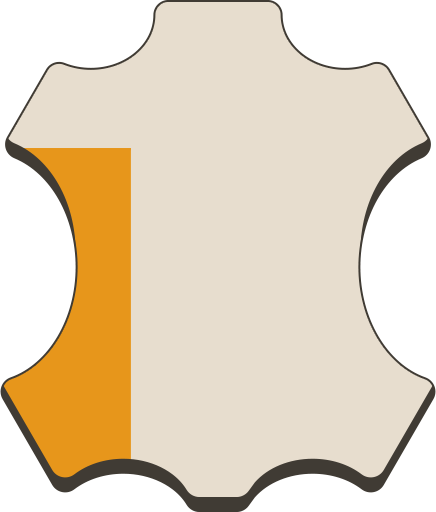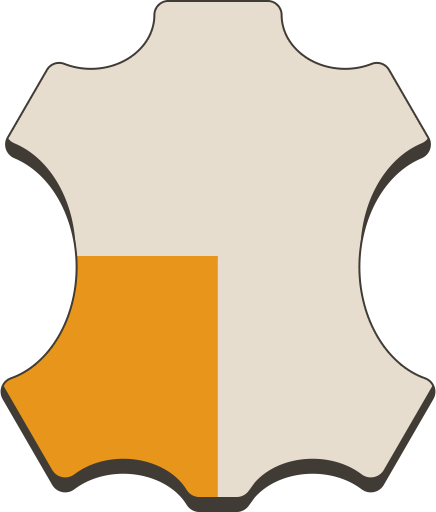Cut Types








Types of leather
The leather / leather industry has had such important growth in recent years that it is difficult to explain the variety of engraved dyed finishes etc etc .. that you can find in the market, in this brief dossier we want to inform about the types of leather but we would like to highlight that due to the constant innovation in the sector it is easy to find the same laminated or pigmented finishes in leather types that years ago it was impossible to make and that now if we hope that this document can be useful in your next leather project / skin.
Bovine
This type of fur comes from cows. Generally, the leather with a regular volume and thickness is chosen, that is to say, that in all its extension it has an equal or similar thickness, in this way a simpler tanning and a higher quality leather is obtained. The cows and heifers provide a leather with elastic and fine fibers, so different elements are made with many details and excellent quality. On the contrary, young bulls, young bulls and bulls provide much thicker and less elastic skin but of very good quality. According to their tanning specifications, they can be found in full grain finishes, with oils or greased and also patent leather finishes.
La Vaquetilla or Vaqueta, the vegetable tanning
We say that a skin is vegetable tanned when during its process we have used vegetable tannins produced in the bark of trees (chestnut, oak, cherry quebracho, among others). During their process, the skins are dipped in tannin to produce a resistant flexible finish used in the vast majority of the industry. A peculiarity of this is skin is that over time it changes color (if exposed to the sun it turns brown) that is due to its chemical-free finish.
Plush Split Leather
It is the result of the division of the bovine / bovine skin, with a velvety touch it can be, engraved, pigmented, with fancy prints etc etc ...
Goats
Their skins result in very fine and very good quality leather, which is why it is intended for making shoes, wallets, gloves, etc. of a high value.
Before
Buckskin is made from the inside of the hide, usually goat, but there is also lamb, beef, or elk. Its softness as well as its thinness make it suitable for garments and delicate uses of leather; Thus, it was originally used to make gloves. Suede is also common in the manufacture of shoes and bags.
Equine
Its thickness and resistance are not as good quality as bovine leathers, however, in the tannery area they bring many gains. Two types of fur are distinguished: the front, which results in a light leather very similar to goat (goats); and the upper part of the hindquarters, where the skin is much thicker and more compact.
Lamb
These animals are mainly destined for the production of fur garments, they have a very good quality, especially if they come from young lambs. These skins also produce bags, shoes, wallets, gloves, etc.
Calves
These leathers come from male dairy calves that are slaughtered at age that provide higher quality. Usually used in High Quality footwear, orthopedic footwear or for delicate feet, Orthopedics are regular clients of this material.
Pigs
Its skin is porous but it results in soft, smooth and strong leather. Once tanned it results in a durable and strong leather. Porosity is generated by the follicles where the hairs originate, as they are very hard and thick. Generally used as shoe linings, leather goods.
Pecary
It is specifically tanned pigskin to make garments, with great quality and a velvety soft touch.
Otters
Its skin has a particular characteristic, it contains two layers. One with thick hair with little commercial value that serves against cold and weather, and another much finer and more commercial value that is used for making covers, scarves, etc.
Reptile skins
These skins do not have hairs but scales which give the leather a very attractive appearance. Their price is very high because their correct tanning is so difficult, since they usually reach very damaged or excessively desiccated refrigerators.
Deer, fallow deer, reindeer and the like
Its leather is usually highly resistant with a rough appearance, in many cases it is used in the manufacture of footwear, wallets, etc ..., if its tanning allows it, garments can also be made.
Patent leather
The leather, generally bovine, is covered by a varnish or polyurethane film, which gives it a very characteristic shine. In addition to being a way to decorate leather, make it waterproof and much more resistant, there is also patent leather on goatskin.
Florentic
Cowhide with tanning similar to patent leather, its finish can be brushed and polished, usually used for men's footwear.
Leather pieces
It is about the cut that industries make when they work the skin, generally they are the corners and unfinished parts, with very different sizes, their sale is always in kg.



